Effects of Land Cover and Atmospheric Input on Nutrient Budget in Subtropical Mountainous Rivers, Northeastern Taiwan
Abstract
:1. Introduction
2. Materials and Methods
2.1. Study Sites
2.2. Water Collections and Chemical Analysis
2.3. Precipitation Estimation and Stream Flow Simulation
2.4. Statistical Nutrient Budget Model
3. Results
3.1. Nutrient Concentrations and Fluxes
3.2. The Nutrient Budget Simulation
4. Discussion
4.1. Characteristics of Precipitation and Stream Water Chemistry
4.2. Indications from the Nutrient Budgets Estimations
5. Conclusions
Supplementary Materials
Author Contributions
Funding
Acknowledgments
Conflicts of Interest
References
- Likens, G.E.; Bormann, F.H. Biogeochemistry of a Forested Ecosystem, 2nd ed.; Springer: New York, NY, USA, 1995. [Google Scholar]
- Padowski, J.C.; Gorelick, S.M. Corrigendum: Global Analysis of Urban Surface Water Quality Supply Vulnerability. Environ. Res. Lett. 2014, 9, 119501. [Google Scholar] [CrossRef]
- Kaushal, S.S.; Groffman, P.M.; Band, L.E.; Shields, C.A.; Morgan, R.P.; Palmer, M.A.; Belt, K.T.; Swan, C.; Findlay, S.E.G.; Fisher, G.T. Interaction between Urbanization and Climate Variability Amplifies Watershed Nitrate Export in Maryland. Environ. Sci. Technol. 2008, 42, 5872–5878. [Google Scholar] [CrossRef] [PubMed]
- Chang, C.-T.; Wang, L.-J.; Huang, J.-C.; Liu, C.-P.; Wang, C.-P.; Lin, N.-H.; Wang, L.; Lin, T.-C. Precipitation controls on nutrient budgets in subtropical and tropical forests and the implications under changing climate. Adv. Water Resour. 2017, 103, 44–50. [Google Scholar] [CrossRef] [Green Version]
- Chang, C.-T.; Huang, J.-C.; Wang, L.; Shih, Y.-T.; Lin, T.-C. Shifts in stream hydrochemistry in responses to typhoon and non-typhoon precipitation. Biogeosciences 2018, 15, 2379–2391. [Google Scholar] [CrossRef] [Green Version]
- Huang, J.-C.; Kao, S.-J.; Lin, C.-Y.; Chang, P.-L.; Lee, T.-Y.; Li, M.-H. Effect of subsampling tropical cyclone rainfall on flood hydrograph response in a subtropical mountainous catchment. J. Hydrol. 2011, 409, 248–261. [Google Scholar] [CrossRef]
- Rankinen, K.; Keinänen, H.; Bernal, J.E.C. Influence of climate and land use changes on nutrient fluxes from Finnish rivers to the Baltic Sea. Agric. Ecosyst. Environ. 2016, 216, 100–115. [Google Scholar] [CrossRef]
- Palmer, S.M.; Driscoll, C.T.; Johnson, C.E. Long-term trends in soil solution and stream water chemistry at the Hubbard Brook Experimental Forest: Relationship with landscape position. Biogeochemistry 2004, 68, 51–70. [Google Scholar] [CrossRef]
- Likens, G.E. Biogeochemistry of a Forested Ecosystem; Springer Science and Business Media LLC: Berlin/Heidelberg, Germany, 2013. [Google Scholar]
- Bobbink, R.; Hicks, K.; Galloway, J.N.; Spranger, T.; Alkemade, R.; Ashmore, M.; Bustamante, M.M.C.; Cinderby, S.; Davidson, E.A.; Dentener, F.; et al. Global assessment of nitrogen deposition effects on terrestrial plant diversity: A synthesis. Ecol. Appl. 2010, 20, 30–59. [Google Scholar] [CrossRef] [Green Version]
- Runyan, C.W.; D’Odorico, P.; Vandecar, K.L.; Das, R.; Schmook, B.; Lawrence, D. Positive Feedbacks Between Phosphorous Deposition and Forest Canopy Trapping Evidence from Southern Mexico. J. Geophy. Res. Biogeosci. 2013, 118, 1521–1531. [Google Scholar] [CrossRef]
- Likens, G.; Driscoll, C.T.; Buso, D.; Siccama, T.; Johnson, C.E.; Lovett, G.M.; Ryan, D.; Fahey, T.; Reiners, W. The biogeochemistry of potassium at Hubbard Brook. Biogeochemistry 1994, 25, 61–125. [Google Scholar] [CrossRef]
- Lovett, G.M.; Likens, G.E.; Buso, D.C.; Driscoll, C.T.; Bailey, S.W. The biogeochemistry of chlorine at Hubbard Brook, New Hampshire, USA. Biogeochemistry 2005, 72, 191–232. [Google Scholar] [CrossRef]
- Driscoll, C.T.; Lawrence, G.B.; Bulger, A.J.; Butler, T.J.; Cronan, C.S.; Eagar, C.; Lambert, K.; Likens, G.E.; Stoddard, J.L.; Weathers, K.C. Acidic Deposition in the Northeastern United States: Sources and Inputs, Ecosystem Effects, and Management Strategies. Bioscience 2001, 51, 180–198. [Google Scholar] [CrossRef] [Green Version]
- Foley, J.A.; DeFries, R.; Asner, G.P.; Barford, C.; Bonan, G.; Carpenter, S.R.; Chapin, F.S.; Coe, M.T.; Daily, G.C.; Gibbs, H.K.; et al. Global Consequences of Land Use. Science 2005, 309, 570–574. [Google Scholar] [CrossRef] [PubMed] [Green Version]
- Grimm, N.B.; Faeth, S.H.; Golubiewski, N.E.; Redman, C.L.; Wu, J.; Bai, X.; Briggs, J.M. Global Change and the Ecology of Cities. Science 2008, 319, 756–760. [Google Scholar] [CrossRef] [Green Version]
- Roa-García, M.C.; Brown, S.; Schreier, H.; Lavkulich, L.M. The role of land use and soils in regulating water flow in small headwater catchments of the Andes. Water Resour. Res. 2011, 47, W05510. [Google Scholar] [CrossRef]
- Gessesse, B.; Bewket, W.; Bräuning, A. Model-Based Characterization and Monitoring of Runoff and Soil Erosion in Response to Land Use/land Cover Changes in the Modjo Watershed, Ethiopia. Land Degrad. Dev. 2014, 26, 711–724. [Google Scholar] [CrossRef]
- Xu, C.; Yang, Z.; Qian, W.; Chen, S.; Liu, X.; Lin, W.; Xiong, D.; Jiang, M.; Chang, C.-T.; Huang, J.-C.; et al. Runoff and soil erosion responses to rainfall and vegetation cover under various afforestation management regimes in subtropical montane forest. Land Degrad. Dev. 2019, 30, 1711–1724. [Google Scholar] [CrossRef]
- Jordan, T.E.; Correll, D.L.; Weller, D.E. Relating nutrient discharges from watersheds to land use and streamflow variability. Water Resour. Res. 1997, 33, 2579–2590. [Google Scholar] [CrossRef]
- Mattsson, T.; Kortelainen, P.; Räike, A. Export of DOM from Boreal Catchments: Impacts of Land Use Cover and Climate. Biogeochemistry 2005, 76, 373–394. [Google Scholar] [CrossRef]
- Kaushal, S.S.; Groffman, P.M.; Band, L.E.; Elliott, E.M.; Shields, C.A.; Kendall, C. Tracking Nonpoint Source Nitrogen Pollution in Human-Impacted Watersheds. Environ. Sci. Technol. 2011, 45, 8225–8232. [Google Scholar] [CrossRef]
- Morse, N.B.; Wollheim, W.M. Climate variability masks the impacts of land use change on nutrient export in a suburbanizing watershed. Biogeochemistry 2014, 121, 45–59. [Google Scholar] [CrossRef]
- Wickham, J.D.; Riitters, K.H.; O’Neill, R.V.; Reckhow, K.H.; Wade, T.G.; Jones, K.B. Land Cover as a Framework for Assessing Risk of Water Pollution. JAWRA J. Am. Water Resour. Assoc. 2000, 36, 1417–1422. [Google Scholar] [CrossRef]
- Allan, J.D. Landscapes and Riverscapes: The Influence of Land Use on Stream Ecosystems. Annu. Rev. Ecol. Evol. Syst. 2004, 35, 257–284. [Google Scholar] [CrossRef] [Green Version]
- Huang, J.-C.; Lee, T.-Y.; Lin, T.-C.; Hein, T.; Lee, L.-C.; Shih, Y.-T.; Kao, S.-J.; Shiah, F.-K.; Lin, N.-H. Effects of different N sources on riverine DIN export and retention in a subtropical high-standing island, Taiwan. Biogeosciences 2016, 13, 1787–1800. [Google Scholar] [CrossRef] [PubMed] [Green Version]
- Lin, T.-C.; Shaner, P.L.; Wang, L.-J.; Shih, Y.-T.; Wang, C.-P.; Huang, G.-H.; Huang, J.-C. Effects of mountain tea plantations on nutrient cycling at upstream watersheds. Hydrol. Earth Syst. Sci. 2015, 19, 4493–4504. [Google Scholar] [CrossRef] [Green Version]
- Lin, T.-C.; Hogan, J.; Chang, C.-T. Tropical Cyclone Ecology: A Scale-Link Perspective. Trends Ecol. Evol. 2020, 35, 594–604. [Google Scholar] [CrossRef] [Green Version]
- Brauman, K.A.; Daily, G.C.; Duarte, T.K.; Mooney, H.A. The Nature and Value of Ecosystem Services: An Overview Highlighting Hydrologic Services. Annu. Rev. Environ. Resour. 2007, 32, 67–98. [Google Scholar] [CrossRef]
- Chang, S.-P.; Wen, C.-G. Changes in water quality in the newly impounded subtropical Feitsui reservoir, Taiwan. JAWRA J. Am. Water Resour. Assoc. 1997, 33, 343–357. [Google Scholar] [CrossRef]
- Chen, Y.-J.C.; Wu, S.-C.; Lee, B.-S.; Hung, C.-C. Behavior of storm-induced suspension interflow in subtropical Feitsui Reservoir, Taiwan. Limnol. Oceanogr. 2006, 51, 1125–1133. [Google Scholar] [CrossRef]
- Zehetner, F.; Vemuri, N.L.; Huh, C.-A.; Kao, S.-J.; Hsu, S.-C.; Huang, J.-C.; Chen, Z.-S. Soil and phosphorus redistribution along a steep tea plantation in the Feitsui reservoir catchment of northern Taiwan. Soil Sci. Plant Nutr. 2008, 54, 618–626. [Google Scholar] [CrossRef]
- Lin, J.Y.; Hsieh, C.-D. A strategy for implementing bmps for controlling nonpoint source pollution: The case of the fei-tsui reservoir watershed in Taiwan. JAWRA J. Am. Water Resour. Assoc. 2003, 39, 401–412. [Google Scholar] [CrossRef]
- Chen, Z.Y. Studies on the Vegetation of the Machilus-Castanopsis Forest Zone in Northern Taiwan. J. Exp. For. Natl. Taiwan Univ. 1993, 7, 127–146, (In Chinese with English Abstract). [Google Scholar]
- Wang, J.C.; Kao, M.F. Vegetation Analysis of the Broad-Leaves Forest of Mt. Wulai, Northern Taiwan. Biol. Bull. NTNU 1994, 29, 113–125, (In Chinese with English Abstract). [Google Scholar]
- Rice, E.W.; Baird, R.B.; Eaton, A.D.; Clesceris, L.S. Standard Method for the Examination of Water and Wastewater, 22nd ed.; American Public Health Association, American Water Works Association, Water Environment Federation: Washington, DC, USA, 2012. [Google Scholar]
- Beven, K.J.; Kirkby, M.J. A physically based, variable contributing area model of basin hydrology/Un modèle à base physique de zone d’appel variable de l’hydrologie du bassin versant. Hydrol. Sci. Bull. 1979, 24, 43–69. [Google Scholar] [CrossRef] [Green Version]
- Beven, K.J.; Freer, J. A dynamic TOPMODEL. Hydrol. Process. 2001, 15, 1993–2011. [Google Scholar] [CrossRef]
- Metcalfe, P.; Beven, K.; Freer, J. Dynamic TOPMODEL: A new implementation in R and its sensitivity to time and space steps. Environ. Model. Softw. 2015, 72, 155–172. [Google Scholar] [CrossRef] [Green Version]
- Takaku, J.; Tadono, T.; Tsutsui, K.; Ichikawa, M. Quality Improvements of ‘AW3D’ Global Dsm Derived from Alos Prism. In Proceedings of the 2018 IEEE International Geoscience and Remote Sensing Symposium, Valencia, Spain, 22–27 July 2018; Institute of Electrical and Electronics Engineers (IEEE): Valencia, Spain, 2018; pp. 1612–1615. [Google Scholar]
- Gupta, H.V.; Kling, H.; Yilmaz, K.K.; Martinez, G.F. Decomposition of the mean squared error and NSE performance criteria: Implications for improving hydrological modelling. J. Hydrol. 2009, 377, 80–91. [Google Scholar] [CrossRef] [Green Version]
- Kling, H.; Fuchs, M.; Paulin, M. Runoff conditions in the upper Danube basin under an ensemble of climate change scenarios. J. Hydrol. 2012, 424, 264–277. [Google Scholar] [CrossRef]
- Turner, M.G. Landscape Ecology: The Effect of Pattern on Process. Annu. Rev. Ecol. Syst. 1989, 20, 171–197. [Google Scholar] [CrossRef]
- Jordan, T.E.; Correll, D.L.; Weller, D. Effects of Agriculture on Discharges of Nutrients from Coastal Plain Watersheds of Chesapeake Bay. J. Environ. Qual. 1997, 26, 836–848. [Google Scholar] [CrossRef] [Green Version]
- Huang, J.-C.; Lee, T.-Y.; Kao, S.-J.; Hsu, S.C.; Lin, H.-J.; Peng, T.-R. Land use effect and hydrological control on nitrate yield in subtropical mountainous watersheds. Hydrol. Earth Syst. Sci. 2012, 16, 699–714. [Google Scholar] [CrossRef] [Green Version]
- Weller, D.; Jordan, T.E.; Correll, D.L.; Liu, Z.-J. Effects of land-use change on nutrient discharges from the Patuxent River watershed. Estuaries 2003, 26, 244–266. [Google Scholar] [CrossRef]
- Castillo, M.M. Land use and topography as predictors of nutrient levels in a tropical catchment. Limnologica 2010, 40, 322–329. [Google Scholar] [CrossRef] [Green Version]
- Uriarte, M.; Yackulic, C.B.; Lim, Y.; Arce-Nazario, J.A. Influence of land use on water quality in a tropical landscape: A multi-scale analysis. Landsc. Ecol. 2011, 26, 1151–1164. [Google Scholar] [CrossRef] [Green Version]
- Akaike, H. A new look at the statistical model identification. IEEE Trans. Autom. Control. 1974, 19, 716–723. [Google Scholar] [CrossRef]
- Segura, C.; James, A.; Lazzati, D.; Roulet, N.T. Scaling relationships for event water contributions and transit times in small-forested catchments in Eastern Quebec. Water Resour. Res. 2012, 48, 07502. [Google Scholar] [CrossRef]
- Nash, J.E.; Sutcliffe, J.V. River Flow Forecasting Through Conceptual Models Part I—A Discussion of Principles. J. Hydrol. 1970, 10, 282–290. [Google Scholar] [CrossRef]
- Sehgal, V.; Tiwari, M.K.; Chatterjee, C. Wavelet Bootstrap Multiple Linear Regression Based Hybrid Modeling for Daily River Discharge Forecasting. Water Resour. Manag. 2014, 28, 2793–2811. [Google Scholar] [CrossRef]
- Cheng, Y.T. Study on the Quality of Hyporheic Zone at Ha-Pen Watershed During Precipitation. Master’s Thesis, National Taiwan University, Taipei, Taiwan, July 2000. (In Chinese with English Abstract). [Google Scholar]
- Nakahara, O.; Takahashi, M.; Sase, H.; Yamada, T.; Matsuda, K.; Ohizumi, T.; Fukuhara, H.; Inoue, T.; Takahashi, A.; Kobayashi, H.; et al. Soil and stream water acidification in a forested catchment in central Japan. Biogeochemistry 2009, 97, 141–158. [Google Scholar] [CrossRef]
- Chang, C.-T.; Wang, C.-P.; Huang, J.-C.; Wang, L.-J.; Liu, C.-P.; Lin, T.-C. Trends of two decadal precipitation chemistry in a subtropical rainforest in East Asia. Sci. Total Environ. 2017, 605, 88–98. [Google Scholar] [CrossRef]
- Hicks, K.; Kuylenstierna, J.C.I.; Owen, A.; Dentener, F.; Seip, H.-M.; Rodhe, H. Soil sensitivity to acidification in Asia: Status and prospects. Ambio 2008, 37, 295–303. [Google Scholar] [CrossRef]
- Àvila, A. Time trends in the precipitation chemistry at a mountain site in Northeastern Spain for the period 1983–1994. Atmos. Environ. 1996, 30, 1363–1373. [Google Scholar] [CrossRef]
- Balestrini, R.; Galli, L.; Tartari, G. Wet and dry atmospheric deposition at prealpine and alpine sites in northern Italy. Atmos. Environ. 2000, 34, 1455–1470. [Google Scholar] [CrossRef]
- Calmels, D.; Galy, A.; Hovius, N.; Bickle, M.; West, A.J.; Chen, M.-C.; Chapman, H. Contribution of deep groundwater to the weathering budget in a rapidly eroding mountain belt, Taiwan. Earth Planet. Sci. Lett. 2011, 303, 48–58. [Google Scholar] [CrossRef]
- Sutherland, A.B.; Meyer, J.L.; Gardiner, E.P. Effects of land cover on sediment regime and fish assemblage structure in four southern Appalachian streams. Freshw. Biol. 2002, 47, 1791–1805. [Google Scholar] [CrossRef]
- Goodale, L.; Thomas, S.A.; Fredriksen, G.; Elliott, E.M.; Flinn, K.M.; Bulter, T.J.; Walter, M.T. Unusual Seasonal Patterns and Inferred Processes of Nitrogen Retention In Forested Headwaters Of The Upper Susqueshanna River. Biogeochemistry 2009, 93, 197–218. [Google Scholar] [CrossRef]
- Duncan, J.M.; Band, L.E.; Groffman, P.M.; Bernhardt, E. Mechanisms Driving the Seasonality of Catchment Scale Nitrate Export: Evidence for Riparian Ecohydrologic Controls. Wat. Resour. Res. 2015, 51, 3982–3997. [Google Scholar] [CrossRef]
- Turner, B.L.; Kasperson, R.E.; Matson, P.A. A framework for vulnerability analysis in sustainability science. Proc. Natl. Acad Sci. USA 2003, 100, 8074–8079. [Google Scholar] [CrossRef] [Green Version]
- Wei, W.; Chen, L.; Fu, B. Effects of Rainfall Change on Water Erosion Processes in Terrestrial Ecosystems: A Review. Prog. Phys. Geogr. Earth Environ. 2009, 33, 307–318. [Google Scholar] [CrossRef]
- Chang, C.-H.; Wen, C.-G.; Huang, C.-H.; Chang, S.-P.; Lee, C.-S. Nonpoint Source Pollution Loading from an Undistributed Tropic Forest Area. Environ. Monit. Assess. 2007, 146, 113–126. [Google Scholar] [CrossRef]
- Reza, A.; Eum, J.; Jung, S.; Choi, Y.; Owen, J.S.; Kim, B. Export of Non-Point Source Suspended Sediment, Nitrogen, and Phosphorous from Sloping Highland Agricultural Fields in the East Asian Monsoon Region. Environ. Monit. Assess. 2016, 188, 692. [Google Scholar] [CrossRef] [PubMed]
- Lee, Y.-J.; Chen, P.-H.; Lee, T.-Y.; Shih, Y.-T.; Huang, J.-C. Temporal Variation Of Chemical Weathering Rate, Source Shifting And Relationship With Physical Erosion In Small Mountainous Rivers, Taiwan. Catena 2020, 425, 93–109. [Google Scholar] [CrossRef]
- Svensson, T.; Lovett, G.M.; Likens, G.E. Is chloride a conservative ion in forest ecosystems? Biogeochemistry 2010, 107, 125–134. [Google Scholar] [CrossRef] [Green Version]
- Shih, Y.-T.; Lee, T.-Y.; Huang, J.-C.; Kao, S.-J. Chang Apportioning riverine DIN load to export coefficients of land uses in an urbanized watershed. Sci. Total Environ. 2016, 560, 1–11. [Google Scholar] [CrossRef] [PubMed]
- Kao, S.-J.; Shiah, F.-K.; Owen, J.S. Export of Dissolved Inorganic Nitrogen in a Partially Cultivated Subtropical Mountainous Watershed in Taiwan. Water Air Soil Pollut. 2004, 156, 211–228. [Google Scholar] [CrossRef]
- Vitousek, P.M.; Naylor, R.; Crews, T.; David, M.B.; Drinkwater, L.E.; Holland, E.; Johnes, P.J.; Katzenberger, J.; Martinelli, L.A.; Matson, P.A.; et al. Nutrient Imbalances in Agricultural Development. Science 2009, 324, 1519–1520. [Google Scholar] [CrossRef] [PubMed]
- Potter, P.; Ramankutty, N.; Bennett, E.M.; Donner, S.D. Characterizing the Spatial Patterns of Global Fertilizer Application and Manure Production. Earth Interact. 2010, 14, 1–22. [Google Scholar] [CrossRef]
- Milliman, J.; Farnsworth, K. River Discharge to the Coastal Ocean—A Global Synthesis; Cambridge University Press: Cambridge, UK; New York, NY, USA, 2011. [Google Scholar]
- Chang, C.-T.; Hamburg, S.P.; Hwong, J.-L.; Lin, N.-H.; Hsueh, M.-L.; Chen, M.-C.; Lin, T.-C. Impacts Of Tropical Cyclones On Hydrochemistry Of A Subtropical Forest. Hydrol. Earth Syst. Sci. 2013, 17, 3815–3826. [Google Scholar] [CrossRef] [Green Version]
- Collins, R.; Jenkins, A. The impact of agricultural land use on stream chemistry in the Middle Hills of the Himalayas, Nepal. J. Hydrol. 1996, 185, 71–86. [Google Scholar] [CrossRef]
- Aquilina, L.; Poszwa, A.; Walter, C.; Vergnaud, V.; Pierson-Wickmann, A.-C.; Ruiz, L. Long-Term Effects of High Nitrogen Loads on Cation and Carbon Riverine Export in Agricultural Catchments. Environ. Sci. Technol. 2012, 46, 9447–9455. [Google Scholar] [CrossRef]
- Pervez, S.; Henebry, G.M. Assessing the Impacts of Climate and Land Use and Land Cover Change on The Freshwater Availability in the Brahmaputra River Basin. J. Hydrol. Reg. Stud. 2015, 3, 285–311. [Google Scholar] [CrossRef] [Green Version]
- Kumar, N.; Singh, S.K.; Singh, V.G.; Dzwairo, B. Investigation of impacts of land use/land cover change on water availability of Tons River Basin, Madhya Pradesh, India. Model. Earth Syst. Environ. 2018, 4, 295–310. [Google Scholar] [CrossRef]
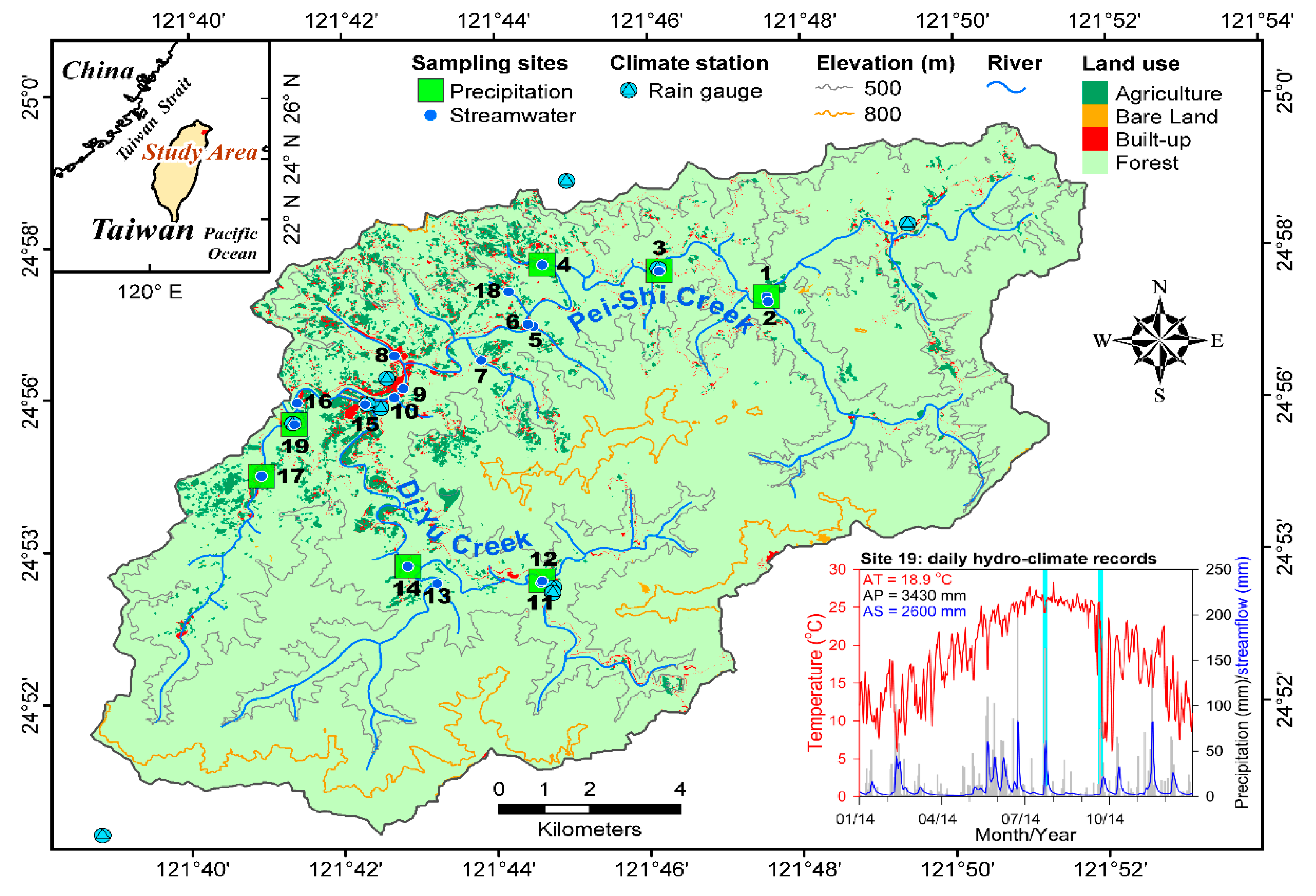
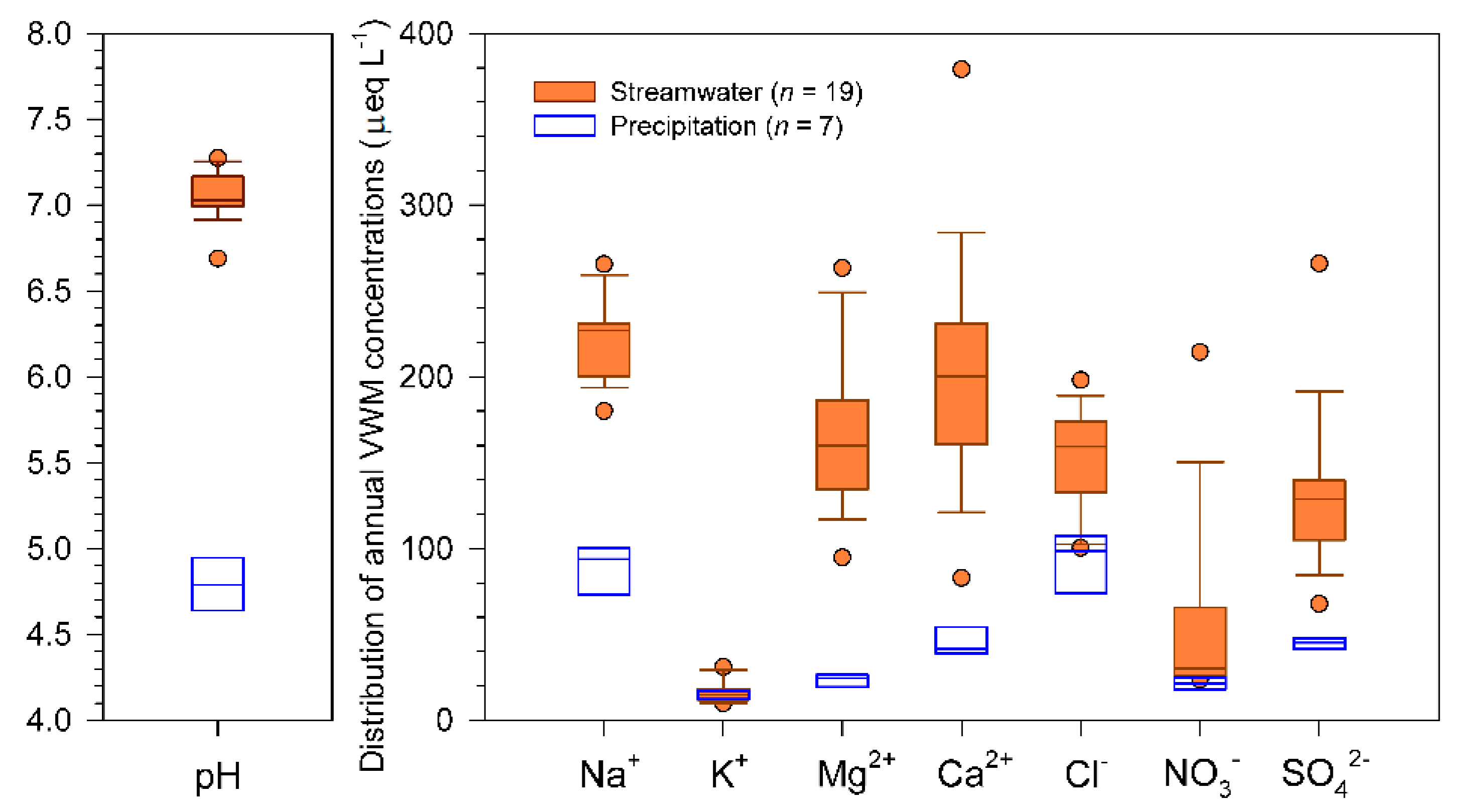
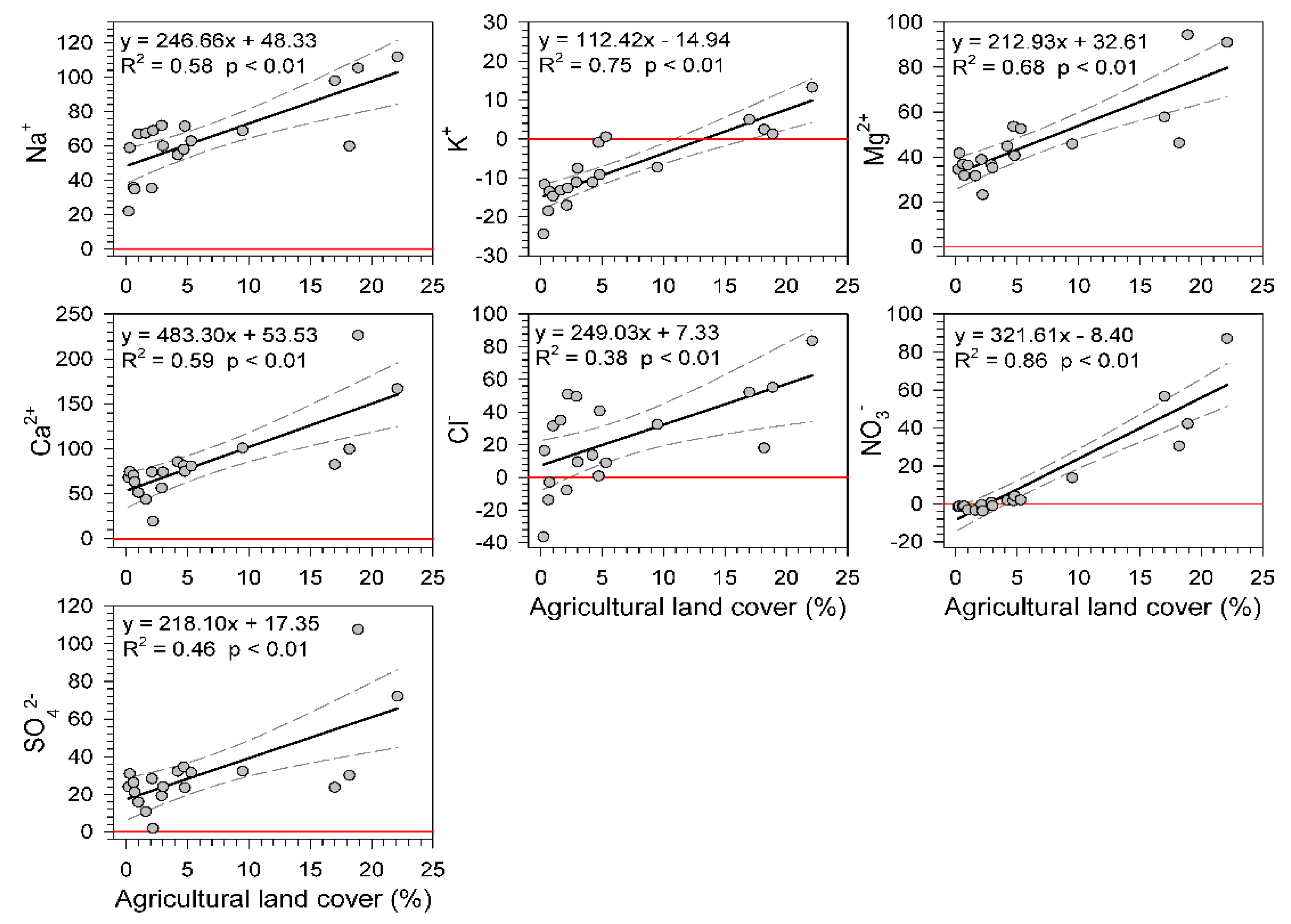
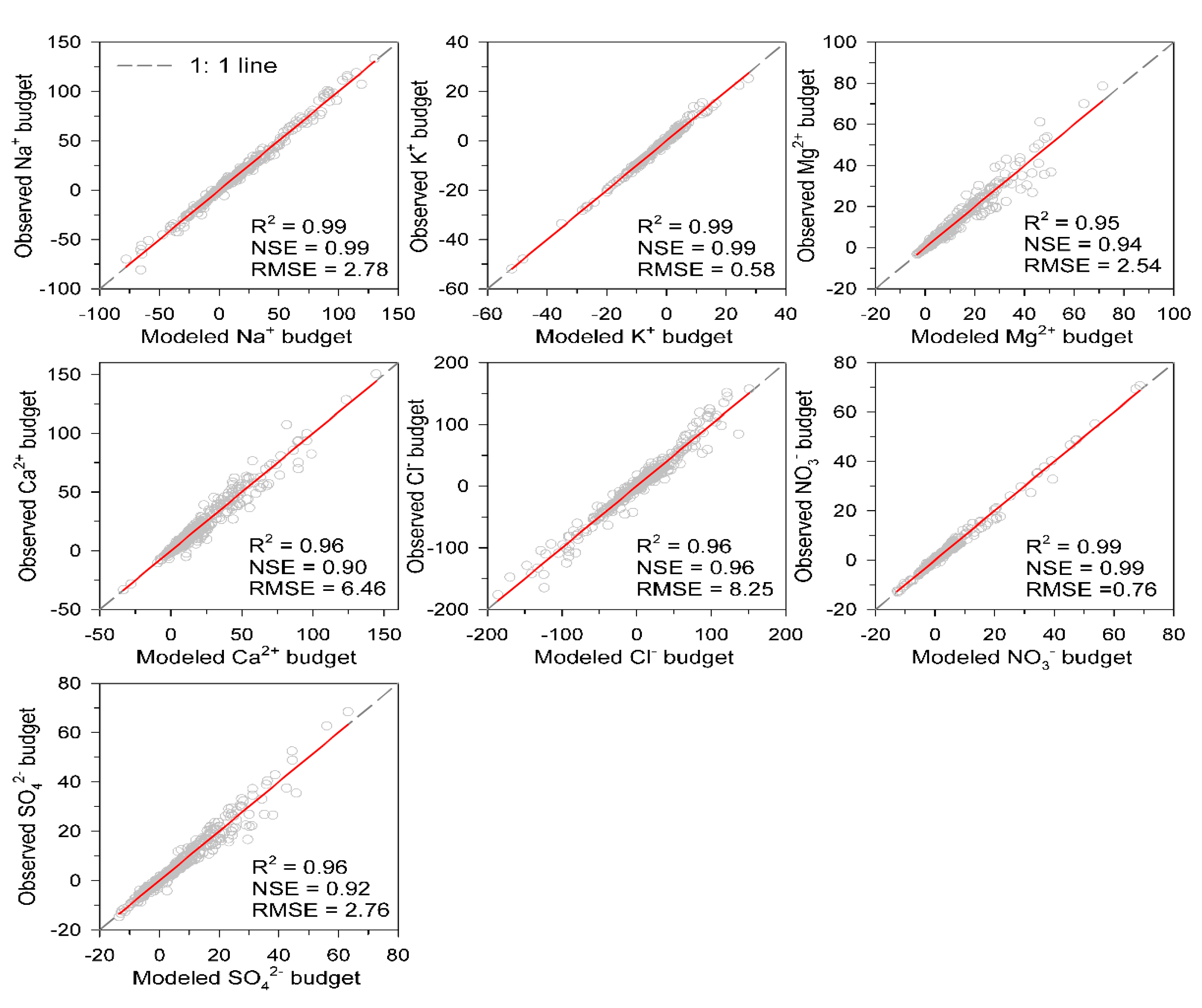
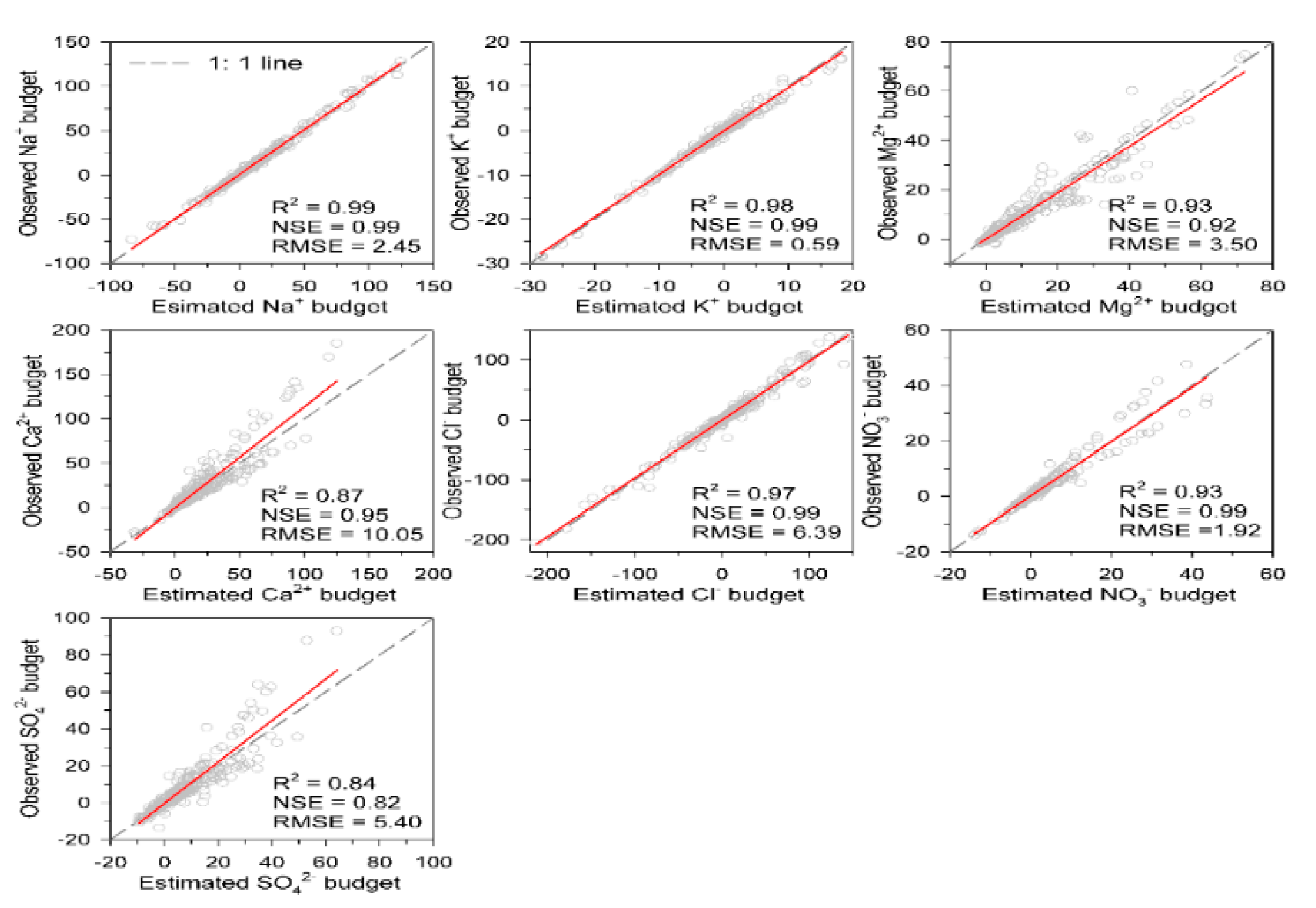
| Sites | Watershed Area (km2) | Average Elevation (m) | Average Slope (%) | Land Use (%) of Watersheds | Budget Model | ||||
|---|---|---|---|---|---|---|---|---|---|
| Forest | Agriculture | Built-Up | Water & Others | Trained | Validated | ||||
| 1 | 28.6 | 484 | 31 | 96.0 | 2.2 | 0.9 | 0.9 | ✓ | |
| 2 | 29.2 | 576 | 41 | 97.9 | 1.0 | 0.3 | 0.8 | ✓ | |
| 3 | 70.5 | 524 | 37 | 96.5 | 1.6 | 0.8 | 1.1 | ✓ | |
| 4 | 2.9 | 484 | 39 | 71.3 | 22.1 | 5.8 | 0.8 | ✓ | |
| 5 | 4.4 | 551 | 54 | 96.1 | 3.0 | 0.4 | 0.5 | ✓ | |
| 6 | 86.0 | 512 | 39 | 94.7 | 2.9 | 1.2 | 1.2 | ✓ | |
| 7 | 6.2 | 554 | 53 | 87.8 | 9.5 | 2.3 | 0.4 | ✓ | |
| 8 | 5.6 | 448 | 44 | 74.3 | 18.9 | 6.3 | 0.5 | ✓ | |
| 9 | 110.4 | 503 | 41 | 91.9 | 4.8 | 1.9 | 1.4 | ✓ | |
| 10 | 2.5 | 493 | 40 | 76.5 | 18.2 | 4.4 | 0.9 | ✓ | |
| 11 | 16.6 | 594 | 46 | 98.0 | 0.7 | 0.8 | 0.5 | ✓ | |
| 12 | 16.8 | 624 | 49 | 98.6 | 0.3 | 0.5 | 0.6 | ✓ | |
| 13 | 24.4 | 647 | 52 | 99.3 | 0.2 | 0.0 | 0.5 | ✓ | |
| 14 | 67.2 | 605 | 49 | 98.2 | 0.6 | 0.5 | 0.7 | ✓ | |
| 15 | 78.9 | 575 | 49 | 96.0 | 2.1 | 0.8 | 1.1 | ✓ | |
| 16 | 195.4 | 528 | 44 | 92.9 | 4.2 | 1.6 | 1.3 | ✓ | |
| 17 | 20.7 | 485 | 45 | 94.2 | 4.7 | 0.4 | 0.7 | ✓ | |
| 18 | 1.4 | 521 | 35 | 78.2 | 17.0 | 4.6 | 0.2 | ✓ | |
| 19 | 22.4 | 471 | 45 | 93.3 | 5.3 | 0.6 | 0.8 | ✓ | |
| Ions | Model 1 | Model 2 | Model 3 | Model 4 | Model 5 | Model 6 | Model 7 | Model 8 |
|---|---|---|---|---|---|---|---|---|
| Na+ | 5834 (0.28) | 3060 (0.99) | 3065 (0.99) | 3060 (0.99) | 3127 (0.98) | 4492 (0.91) | 3076 (0.99) | 3947 (0.96) |
| K+ | 4114 (0.13) | 2560 (0.92) | 1021 (0.99) | 1021 (0.99) | 1021 (0.99) | 1040 (0.98) | 1025 (0.99) | 1379 (0.98) |
| Mg2+ | 3480 (0.88) | 3388 (0.86) | 3056 (0.93) | 3054 (0.94) | 3073 (0.94) | 2864 (0.95) | 3085 (0.93) | 3077 (0.94) |
| Ca2+ | 4532 (0.84) | 4502 (0.85) | 4264 (0.89) | 4262 (0.89) | 4229 (0.89) | 3660 (0.96) | 4357 (0.89) | 4303 (0.89) |
| Cl− | 6536 (0.96) | 4474 (0.96) | 4476 (0.96) | 4472 (0.96) | 4493 (0.96) | 5132 (0.96) | 4475 (0.96) | 4795 (0.93) |
| NO3− | 3057 (0.34) | 4222 (0.34) | 1385 (0.99) | 1385 (0.99) | 1626 (0.98) | 1428 (0.99) | 1436 (0.98) | 1442 (0.99) |
| SO42− | 4087 (0.87) | 3451 (0.87) | 3165 (0.92) | 3162 (0.92) | 3153 (0.87) | 2683 (0.96) | 3168 (0.91) | 2888 (0.92) |
| Ions | Regression Fitting Models |
|---|---|
| Na+ | |
| K+ | |
| Mg2+ | |
| Ca2+ | |
| Cl− | |
| NO3− | |
| SO42− |
© 2020 by the authors. Licensee MDPI, Basel, Switzerland. This article is an open access article distributed under the terms and conditions of the Creative Commons Attribution (CC BY) license (http://creativecommons.org/licenses/by/4.0/).
Share and Cite
Chang, C.-T.; Shih, Y.-T.; Lee, L.-C.; Lee, J.-Y.; Lee, T.-Y.; Lin, T.-C.; Huang, J.-C. Effects of Land Cover and Atmospheric Input on Nutrient Budget in Subtropical Mountainous Rivers, Northeastern Taiwan. Water 2020, 12, 2800. https://doi.org/10.3390/w12102800
Chang C-T, Shih Y-T, Lee L-C, Lee J-Y, Lee T-Y, Lin T-C, Huang J-C. Effects of Land Cover and Atmospheric Input on Nutrient Budget in Subtropical Mountainous Rivers, Northeastern Taiwan. Water. 2020; 12(10):2800. https://doi.org/10.3390/w12102800
Chicago/Turabian StyleChang, Chung-Te, Yu-Ting Shih, Li-Chin Lee, Jun-Yi Lee, Tsung-Yu Lee, Teng-Chiu Lin, and Jr-Chuan Huang. 2020. "Effects of Land Cover and Atmospheric Input on Nutrient Budget in Subtropical Mountainous Rivers, Northeastern Taiwan" Water 12, no. 10: 2800. https://doi.org/10.3390/w12102800
APA StyleChang, C.-T., Shih, Y.-T., Lee, L.-C., Lee, J.-Y., Lee, T.-Y., Lin, T.-C., & Huang, J.-C. (2020). Effects of Land Cover and Atmospheric Input on Nutrient Budget in Subtropical Mountainous Rivers, Northeastern Taiwan. Water, 12(10), 2800. https://doi.org/10.3390/w12102800









